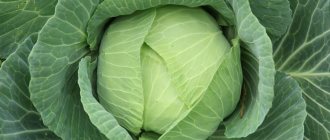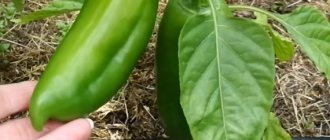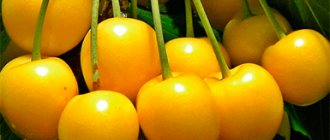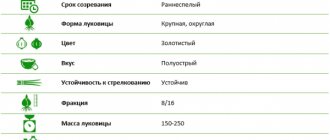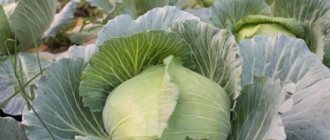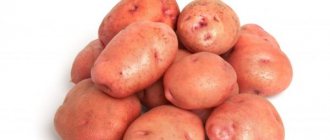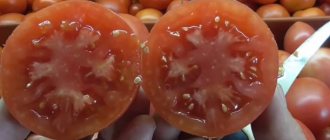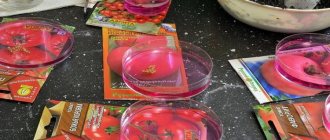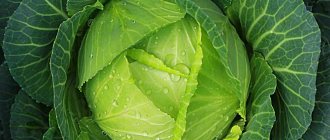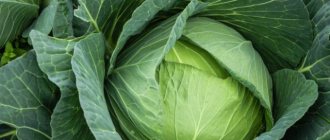Amager or Amager 611?
Beginner gardeners often ask what the cabbage is called: Amager or Amager 611? It must be said that both names are correct. Initially, VNIISSOK developed a variety whose name included numbers. It was intended for planting in all regions of our vast Motherland, with the exception of the northernmost corners, where the late garden crop does not have time to ripen.
But after some period of time, small varietal changes occurred. Amager 611 cabbage seeds, which were collected in the southern regions of the country, became more resistant to elevated daytime temperatures. The crop has little resistance to the effects of drought. At the same time, all the main varietal characteristics were preserved in full. This “subvariety,” so to speak, began to be called without numbers.
Now on the territory of the Russian Federation, most often, if not everywhere, you can find bags of Amager 611 seeds. In Moldova, Kazakhstan, Ukraine and other former Soviet republics, in most cases Amager cabbage seeds are found on the shelves of agricultural stores.
Preparing seeds for planting
Amager cabbage seeds
Cabbage of this variety is grown in seedlings or sown in the ground.
To increase immunity to diseases, the seeds are treated with a solution of Fitosporin . Soak for 8-10 hours. The same solution is used to disinfect the soil for sowing. This treatment is carried out a day before sowing and reduces the risk of various diseases.
Description
The description of Amager cabbage must begin by indicating that it is a late-ripening variety. Forks should be collected 150-175 days after the emergence of mass shoots of the crop. The rosette is formed of a semi-spreading type. The leaves are wide, semi-concave, well raised from the ground. The edges of the leaf blade are rounded with barely noticeable teeth, more reminiscent of a wavy line. The color of the leaf is gray-green with a pronounced waxy coating. There is no wrinkling.
The head of cabbage is formed of impressive size, on average 2400-4000 g. The outer stump is of medium length, the inner one is small. The fork is formed as a very dense, rounded-flat, sometimes rounded-concave or rounded. Cabbage yield is high - up to 6 kg/sq. meter. Suitable for growing on an industrial scale. In this case, the yield reaches 65 tons/ha. Plants develop evenly, so mechanized harvesting is possible. Tolerates transportation well.
How to plant and grow Amager cabbage: variety description
Amager cabbage is a well-known variety that today is widely popular among consumers of quality vegetable products. This is due to the fact that the variety has a huge range of advantages. In addition, cabbage produces a high-quality and abundant harvest, it does not cause difficulties in the process of care, so it is perfect for inexperienced gardeners.
Characteristic
This variety is considered late in terms of cabbage ripening. It will be possible to observe the harvest only 150 days after planting the seedlings. The bushes have a semi-spreading rosette. The leaves are wide and half-bent, they are raised from the ground. Their edges resemble a wavy line. The color of the foliage is gray-green, there is a pronounced waxy coating. Wrinkling is not typical for this variety.
The head of cabbage has an impressive size - 2.4-4 kg. The outer stump is medium in length, and the inner one is small. The head of cabbage has a high density, rounded-flat shape. The yield is 6 kg per 1 m2. Amager can be used for growing on an industrial scale. Then the yield will be 65 tons per hectare. But how to plant Brussels sprouts in open ground, and how to do it yourself, is indicated in this article.
How and when to plant
Since Amager is a representative of late cabbage, it can be grown either by seedlings or without seedlings.
If we are talking about the northern regions, then due to the short summer it is better to choose seedlings. Since the variety is often exposed to various diseases, the planting material must be kept in a Fitosporin solution before planting. The duration of soaking is 8-12 hours. The soil for sowing must be disinfected with the same Fitosporin. Do this a day before planting events.
Planting should be done in April. But to plant the seedlings in a permanent place - in early May, using additional cover with film stretched over the arches. If the temperature is 20 degrees, then the first shoots of cabbage can be seen in 2-5 days.
As soon as the plants emerge from the ground, move the seedlings to a cooler room where the temperature does not exceed 11 degrees. Keep it there for 11-15 days. If this condition is not met, the plants will begin to stretch and may subsequently die.
But how to grow Brussels sprouts from seeds, and how complicated the process of planting and growing is, can be seen in this video.
A greenhouse or greenhouse is best suited for seedlings. There it is absolutely easy to maintain the necessary conditions for seedlings. After 14 days, you can pick the seedlings, placing them in separate cups. Plants will have to be deepened up to the cotyledon leaves. When the picking was completed, water the seedlings with a solution of Fitosporin.
In the video - planting cabbage seeds:
Planting at a permanent location takes place at the end of May. A distance of 50-60 cm should be maintained between seedlings, but between rows it will be 60-70 cm. After planting, sprinkle the soil with tobacco dust and wood ash. This way, it will be possible to simultaneously repel pests and at the same time fertilize the soil.
What the Megaton cabbage variety looks like and how easy it is to grow it is described in this article.
It will also be useful to learn more about what cabbage of the Podarok variety looks like in the photo
How to care
To get a decent harvest, you must follow some rules regarding watering:
- Moisturizing should only be done early in the morning or evening.
- The variety in question responds positively to moisture . The frequency of watering is determined taking into account the characteristics of the soil and weather conditions in the region. Irrigation should be carried out 2 times every 7 days. And thanks to the mulching layer, it is possible to reduce watering to 1 time.
- Irrigation is carried out using warm water . If you use cold liquid, the plant will stop growing fully, and diseases of the root system may also occur.
- As harvest time approaches, it is necessary to reduce the amount of moisture. This will prevent the fruit from cracking. 30 days before harvesting the heads of cabbage, stop watering altogether. But how to get a good harvest of cabbage, and what you should pay attention to when planting, is outlined here.
Video shows how to care for cabbage:
Mulching, hilling and fertilizing
To reduce the number of waterings of cabbage, you need to take care of laying a mulch layer. It can be done using various materials. Very often, gardeners use fallen leaves or plant remains. Thanks to mulching, the soil will always be protected from drying out, erosion and weathering.
Hilling also has a positive effect on the plant. Due to this procedure, it is possible to obtain a powerful and strong root system.
For the plant to grow fully, it is necessary to apply fertilizers. Do this at least 2-3 times every 30 days. This is the first time you will need to use nitrogen fertilizers. Thanks to them, accelerated cultural growth is achieved. Mullein, ammonium nitrate or potassium humate are excellent for this.
It will also be useful for you to learn more about it. how to sow broccoli for seedlings.
Video shows how to hill cabbage:
For the full development of the plant, it is necessary to take care of applying phosphorus fertilizers. Ammonium hydrogen phosphate and superphosphate are suitable for this. In August, it is necessary to use nitrophoska as a top dressing.
In addition to store-bought medications, you can use the following home remedies:
- Boric acid;
- Baking soda;
- Young nettle;
- Ammonia.
Pest Control
Amager cabbage has many enemies in the form of various parasites. Its leaves provide succulent food for the cruciferous flea beetle, cabbage moth, aphids, and tears. It is best to fight them with the help of plants such as mint, wormwood, and cilantro. They need to be planted in a neighboring bed.
You can also use chemicals. But do this only as a last resort. The following effective drugs are sold in stores: Caviar-M, Fury, Kemiros.
Reviews when growing
- Oleg, 57 years old: “I’ve been growing cabbage for sale for 2 years now. Among the late-ripening varieties, I have the Amager variety. I want to say that he needs to be looked after thoroughly. Especially, timely treatment of plants against pests and diseases. More than once I have dug up bushes affected by blackleg or powdery mildew. This year I carried out treatment in the spring for preventive purposes, I also monitor the soil moisture, and laid a mulching layer of sawdust.”
- Marina, 38 years old: “The Amager variety is unique for me in that it is not picky about the type of soil. But you can’t grow it in one place every year. Dolomite flour will allow me to fight pests. I just scatter it over the surface of the soil. I use the seedling method for growing, because then the plants are more hardy and strong.”
And here you can read reviews from gardeners on how to plant cauliflower seedlings.
Amager is a late variety of cabbage that produces a harvest in August. The variety is undemanding regarding the type of soil and growing conditions, but the plant does not have strong immunity to pests and diseases. So you will have to pay due attention to prevention so as not to lose the entire harvest later.
Peculiarities
When writing a description of the Amager cabbage variety, mention should be made of its features. Among the advantages, undoubtedly, it is necessary to highlight increased shelf life. The fruits can be stored until April. At the same time, the taste will only improve. If at harvest the taste rating is only 3.5 points, then after 2-3 months of storage it increases to 4.5 points.
Resistance to cracking and frost resistance should also be emphasized. Planting seeds and seedlings in the ground is possible even on the eve of late spring frosts. Forks ripening in beds can tolerate up to minus three degrees Celsius.
The disadvantages of the variety are its susceptibility to some cabbage diseases. In particular, with inept agricultural technology, there is a risk that the forks will catch black rot (fusarium) or vascular bacteriosis. During storage, punctate necrosis may also occur.
Also in the description of Amager 611 cabbage, it must be emphasized that there is such a drawback as the inability to tolerate extremely high temperatures. With prolonged exposure to forks, growth stops and needs abundant watering.
Description of the Amager cabbage variety, characteristics and cultivation
Those who grow vegetables in their garden are looking for varieties with positive characteristics - Amager 611 cabbage is an excellent option. The variety has been grown on the Russian market since 1943. Popular due to its excellent taste and disease resistance. Therefore, I received numerous positive reviews from agronomists and ordinary summer residents.
Characteristics of the variety
Amager or Amager 611 is a variety of white cabbage with a late ripening period, grown throughout the Russian Federation, but ripening times differ in different regions. The characteristic of the variety is that, due to its resistance to cold weather, it is planted in early spring. The ripening period of forks is late - 150-170 days after planting seeds for seedlings.
Description of the Amager cabbage variety - forms a semi-spreading rosette with bright green leaves raised above the fork. The stalk reaches a length of 27 centimeters.
The leaf is smooth, wavy along the edge, and strongly concave in the head. The color of the leaves is green with blue and purple tints and a waxy coating.
The head of cabbage is dense and has a round-concave shape. The weight of one head of cabbage reaches 4 kilograms. High yield variety.
Features of the variety
The variety is popular and has received positive reviews for many years due to its resistance to weather changes and much more:
- Keeping quality.
- Resistant to cracking.
- Cold tolerance.
- Resistant to drought and heat.
Seedlings are not damaged by frost, and forks that are not harvested in time can withstand temperatures down to -3°C. At the same time, at the beginning of storage, the vegetable contains less vitamins and minerals than a head of cabbage that has been stored for 2-3 months.
Despite the positive aspects of cabbage, the variety also has negative qualities. It is susceptible to fusarium and vascular bacteriosis if the plant is not properly cared for. During storage, pinpoint necrosis may occur. At prolonged extremely high temperatures, the head of cabbage stops growing and requires watering.
Growing conditions
As mentioned earlier, Amager 611 is grown everywhere in two ways, excluding the northernmost regions of Russia - there the heads of cabbage do not have time to ripen.
- Sowing seeds in the ground.
- Sowing seeds for seedlings.
The seeds are planted directly at the end of April, while in regions with cold climates it is advisable to grow cabbage only by seedlings. The agricultural technology of sowing is as follows. Cabbage seeds are sown for seedlings in late March - early April, while the grown seedlings are transplanted into open ground starting from the end of April. Growing times vary in different regions.
Watering plants
To obtain a good harvest of Amager cabbage, constant, abundant watering is important. Use water heated to summer temperature. Cold water will delay plant development and harvest. Usually, cabbage seedlings are watered at the root in specially prepared holes - a hole is made around the trunk of the crop, raising the soil along the edges so that the water does not leak out. It is not recommended to pour water on the leaves - it will cause sunburn.
Two months before harvesting, watering is reduced in order to prevent cracking of ripe heads of cabbage. Watering is stopped completely within a month.
To reduce water consumption when watering around plants, mulch the soil. In such soil, fewer weeds grow, and watering is reduced to once a week.
Plant nutrition
Fertilizers are applied at least once a month. 2 weeks after planting the seeds, the seedlings are fed with a mixture of urea and potassium fertilizers, superphosphate and water in a ratio of 10:20:10.
When planting seedlings, organic fertilizers are added to the holes. Subsequent fertilizing is carried out no earlier than 15 days after planting the seedlings in the ground. The following materials are used as fertilizers:
- rotted grass,
- compost,
- mullein,
- chicken droppings,
- potassium chloride,
- superphosphate,
- urea,
- boric acid,
- wood ash.
These fertilizers are alternated with each other or used in combination - 2-3 fertilizers once a month.
Late feeding in August is carried out to increase the winter storage period and improve the quality of late heads of cabbage. For this purpose, potassium, nitrogen, mullein, and boric acid are used.
Disease Prevention
After planting in the garden, the plants need to be constantly monitored in order to identify the disease and immediately begin to fight it.
As a rule, cabbage is overcome by several infections - downy mildew, black leg, clubroot. The diseases are serious, and subsequently the vegetables do not ripen or die. It is important to detect the infection in time. When transplanting seedlings, carefully examine the roots of the plants for the presence of growths; the stems should be green without dark spots, and the leaves should be free of any plaque, lethargy, or dried parts. If signs of disease are detected, the infected seedlings are destroyed. Planting one diseased seedling in a garden bed will destroy the entire plot.
Reviews about the variety Amager 611
Over the long period of planting in Russia, the variety has received numerous reviews from agronomists, gardeners and ordinary garden plot owners. Let's take a look at some of them:
Marina Vladimirovna from Volgograd writes: “I have been growing Amager 611 on my plot for many years and always get an excellent harvest of large heads of cabbage. Cabbage does not require much attention during growth; by September-October, the heads of cabbage weigh about 5 kilograms. It is perfectly stored in the cellar throughout the winter, the heads of cabbage do not rot. Until spring, we use almost the entire harvest; there is enough to distribute to relatives and treat neighbors.”
Dmitry Aleksandrovich from Ufa: “I planted the variety last year, the late heads of cabbage ripened by the end of September. During growth, they never got sick, didn’t have to be treated with poison, are demanding of fertilizers and watering, are afraid of heat, but they also don’t welcome high humidity - one head of cabbage festered, but we immediately put it into cabbage soup. The harvest is excellent, we will use this variety again.”
Agricultural technology
This cabbage is planted for seedlings at the end of February-March. Seeds can be sown in open ground as early as the first days of April (in the southern regions) and in the last days of April (in central Russia). In more northern regions they are planted only by seedlings. The seedlings are ready for planting 40 days after germination.
This cabbage should be planted at a distance of 60-70 cm from each other. The seeding depth is 1.5-2 cm. When planting fresh (!) seedlings, the cabbage stem can be immersed before the leaf blades begin.
This variety is moisture-loving. Therefore, watering should be carried out at least 2 times a week. If the root area is mulched, you can water it once a week. Due to the highly raised leaves, it requires hilling. It responds well to this method of agricultural technology and forms a powerful root system. Fertilizing has a beneficial effect on cabbage. They should be carried out at least 2-3 times a month.
How to plant and grow Amager cabbage
Gardeners who have been growing vegetables for a long time are looking for crops with good characteristics and positive reviews. The Amager cabbage variety is an excellent solution for a personal plot. Both experienced agronomists and ordinary summer residents are unanimous in their opinion about this variety. This plant has excellent taste, valuable healing qualities, is resistant to diseases and is easy to care for. For this reason it is very popular.
Description and characteristics of the variety
Breeders began breeding the Amager variety back in 1927. But it was registered only in the middle of the Great Patriotic War. Still in demand now. Cabbage of this type is popular not only among private gardeners, but is also purchased for industrial needs.
Amager 611 cabbage is considered a late-ripening vegetable crop of the cruciferous family. The rosette is spreading with leaves sticking up. It has large dense heads of cabbage reaching more than 1 meter in diameter. Their weight varies from 2 to 4 kilograms.
The forks are flattened with wide wavy leaves along the edge. A more detailed examination of the sheet plate reveals the presence of teeth along the edge. The color of the head of cabbage is grayish-green with a slight waxy coating. The structure is dense and juicy. Does not crack during ripening and storage.
Has high productivity. Has a long shelf life. During which, the taste of the vegetable becomes even better.
For reference! Out of ignorance, some people call the cabbage variety Magera, which is fundamentally wrong - the official name of the variety is Amager.
Advantages and disadvantages of the variety
Like any variety, Amager has its pros and cons. This cabbage will withstand any competition from more modern varieties, as it boasts the following advantages:
- not susceptible to sudden changes in temperature and its decrease;
- is able to retain positive qualities for a long time (can remain until July);
- heads of cabbage are not injured from mechanical stress;
- unpretentious in transportation;
- always gives a high yield;
- the heads of cabbage do not crack even with high humidity.
Despite its many advantages, the vegetable is not without some disadvantages. Namely:
- susceptible to some diseases (such as gray rot, spot necrosis and Fusarium wilt);
- After harvest, there is a bitterness in the taste, which disappears during storage.
Attention! Disadvantages manifest themselves most strongly with improper care by inexperienced gardeners.
Growing conditions
Like all late-ripening varieties, Amager is grown by seeds and seedlings. Due to the fact that many northern regions have short summers, growing the crop is recommended by seedlings. Otherwise, the heads of cabbage simply will not have time to ripen.
Seed preparation
Proper and timely preparation of seeds for planting is the key to a rich and healthy harvest. To do this, they are immersed in water for 15 minutes, the temperature of which should be clearly 50 degrees. Then transfer to cool water for 1 minute.
The next step will be soaking the seeds for twelve hours in a solution of mineral fertilizers. Next, they are washed under running water. After all the above procedures, the seeds are kept in the refrigerator for a day.
Transplanting
Planting seedlings begins in late February or early March.
- Prepared and processed seeds are dried and placed in containers with soil taken from the place where they will then grow directly.
- A day before planting grains, the soil must be disinfected. To do this, pour boiling water or Fitosporin over it.
- Next, the seeds are planted in special containers and covered with glass or film. The containers are left in a warm place until the sprouts appear. After a week, you can already observe the first shoots.
- After the sprouts appear, picking is carried out. Each young bush is planted in a separate container.
- After picking, the seedlings are once again treated with Fitosporin.
- The grown cabbage seedlings are planted in a permanent place closer to mid-May.
- The soil of the plot is fertilized, dug up and loosened.
- In the beds, plants should be no closer to each other than 60 cm.
- After planting, the soil is sprinkled with ash to prevent pests.
- The bushes are dug in up to the first leaf.
Growing by seeds
Growing Amager cabbage from seeds in open ground is almost no different from the seedling method. In the southern regions, planting occurs in early April, and in the regions of central Russia at the end.
Reviews
Reviews about Amager cabbage are very different. Someone complains that the variety is very susceptible to Fusarium wilt. For some, it even begins literally immediately after the formation of the head begins. Others report that diseases are nothing, but the bitterness in the leaves persists for the first 2 months and is felt very strongly. But both of them confirm the high, stable yield of Amager cabbage. However, judge for yourself whether this variety is suitable for you or not.
Natalya, Odessa region The variety is not bad, I have been growing it for many years. Forms heads of cabbage together, 3-4 kg each. Sometimes there are heads weighing 6-8 kg, but this is rare. It lies in the cellar until spring, then you need to peel off the top leaves - it begins to rot.
Oleg, Voronezh region Amager cabbage was grown by my grandfather. Excellent variety, I like it. True, sometimes the roots of purchased seedlings rot. You just plant it, and after a couple of days it starts to rot. I stopped buying seedlings, my wife began to grow them herself, pre-treating the seeds, and they forgot about rotting. For prevention, I also treat the cabbage area with Trichodermin. Pah-pah, but so far it helps.
Valery, Chelyabinsk region I grow Amager 611 in a greenhouse. I have no complaints about the variety. It grows well, sets large forks, and is stored for a long time. Nice cabbage!
Characteristics of Amager cabbage variety
One of the oldest, but still popular varieties is Amager cabbage. Amager 611 cabbage was bred by breeders back in the 20s of the last century. The qualities of this variety make it possible to obtain high yields even from a small plot.
Characteristics of Amager cabbage variety
Characteristics of the variety
About 145-155 days pass from the moment of seed germination to harvesting, so the variety is considered late-ripening. In hot summers these dates shift.
The cabbage variety Amager 611 is productive: up to 7 kg of high-quality heads of cabbage are harvested from 1 m². Its only drawback is low resistance to some diseases.
Description of the head of cabbage
The description of Amager cabbage notes the high quality of the heads. The variety has excellent keeping quality and is stored in the basement until late spring. If the room is damp and poorly ventilated, the heads of cabbage may rot. The upper leaves and cut are the first to be affected.
Immediately after harvest, the leaves of the heads of cabbage have a characteristic bitterness, which disappears after 2-3 months of storage. They also become more juicy.
Forks are stored on wooden or plastic pallets with the cut side up. The heads of cabbage are laid in one layer, leaving a small distance between them. Periodically check the condition of vegetables and remove rotten or moldy leaves.
Application of the vegetable
The variety is suitable for preparing first and second courses, as well as canning. Cabbage should not be pickled or fermented, as its leaves are too hard, and this affects the taste of the finished product.
Summary varietal characteristics
| Variety or hybrid | variety |
| Ripening period | late |
| Kochan | rounded flat, dense |
| Kocheryzhka | small |
| Disease resistance | susceptible to fusarium wilt, vascular bacteriosis |
| Fruit weight, g | 2400-4000 |
| Growing areas | from the southern regions of the Russian Federation to the Urals, as well as Ukraine, Moldova, Kazakhstan. |
| Disembarkation scheme | 60-70cm x 60cm |
| From germination to ripeness | 150-175 days |
| Seed placement depth | 1.5-2 cm |
| Seedling age | 40 days |
| Soil temperature for planting seeds/seedlings | +4/+12 |
| Advantages | can be stored for a long time, is transportable, produces a stable high yield |
| Flaws | demanding of soil fertility, moisture-loving, cannot tolerate high temperatures, not suitable for pickling in the first 2 months after harvesting |
Pests and diseases
Growing this variety is difficult due to its susceptibility to cruciferous diseases. Everyone who has planted Amager notes that most often the plant suffers from:
- Downy mildew (leaf spotting). The causative agent is a fungus. The disease manifests itself at the seedling stage. Affected leaves quickly dry out and fall off
- Powdery mildew (gray spots on heads of cabbage). It quickly spreads throughout the plant and makes the plug unsuitable for storage for a long time.
- Fusarium (appearance of yellow veins on leaves). Infected plants form loose small forks or stop growing altogether. The disease enters the soil through infected seeds.
The main pests of this vegetable are cruciferous flea beetles, slugs and grape snails. They feed on the juicy greens of the plant and thereby damage the head of cabbage.
Harvest and storage
The crop is harvested depending on its ripeness. Usually this is the end of September - October . Cut the heads of cabbage with a knife, leaving a long stalk. Collection is best done in dry weather.
Before storing, each head of cabbage must be inspected. Thicker ones will last longer. It is recommended to tear off excess leaves and dry them in the open air for several hours.
The Amager variety is harvested at the end of September-October
High humidity and sharp temperature fluctuations in the storage facility create favorable conditions for the development of gray rot . First of all, it affects deformed or frozen cabbage. Affected heads of cabbage are isolated, and storage areas are treated with antifungal drugs.
Growing Amager cabbage, subject to certain rules, does not present any particular difficulties. The result of constant watering, timely fertilizing and disease prevention will be a generous harvest that will be stored all winter. Having advantages over other types of cabbage, it is very popular among gardeners.
Growing seedlings
Sowing is carried out in early April to a depth of 2 cm . Cover with film to create a greenhouse effect. At a temperature of about 20 degrees and good lighting, seedlings will appear on the 4th – 5th day.
After this, the seedlings must be moved to a cooler place . If this is not done, the sprouts will begin to stretch, weaken and may die. After 12-15 days, the seedlings are planted into separate containers. Water once a day with warm water in the morning.
Planting and collection schedule:
In the phase of the third true leaf, the first feeding is carried out, the second - when the fourth leaf appears.
Fertilizer application scheme
For proper development of the plant, it is necessary to apply fertilizers. After planting in the ground, the first fertilizing is carried out 15 days later with a liquid solution of minerals. In a bucket of water, 20g of potassium fertilizer and superphosphate, 10g of urea are diluted. This solution promotes enhanced growth of the crop.
A very good remedy is mullein infusion . It is prepared at the rate of: a bucket of mullein per ten buckets of water. They insist for two days. Apply half a liter to each bush.
The second feeding of cabbage is carried out two weeks after the first. One liter per hole. You can reuse mullein or prepare an infusion of chicken manure in a ratio of 1:25.
Wood ash is sprinkled on cabbage leaves to combat pests, and poured under the root as an infusion. Mineral fertilizers affect the formation of large heads and improve the taste of cabbage.
Wood ash dusting is used for pest control
a third time after 10 days according to the same scheme. Two weeks before harvesting, cabbage is fed a fourth time to improve storage properties.
Fertilizers should be applied after watering or rain. It is necessary to ensure that fertilizer solutions do not fall on the leaves.
